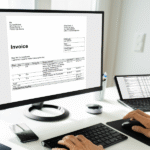Deadline 2025 for e-invoicing in Singapore represents a new era of financial compliance and tax reporting that businesses must adopt. With effect from 1 Nov 2025, newly GST-registered businesses will need to issue and receive invoices electronically via InvoiceNow Singapore that is based on world standards and adopted internationally through the global Peppol e-invoicing network.
InvoiceNow isn’t just electronic invoices. It is a structured invoicing format that enables machine-reading, interoperability, automation and it satisfies Invoice Singapore GST requirement. Companies that view InvoiceNow as “another compliance obligation” will risk being disrupted, rejected and are likely to not be in compliance.
To prevent you from encountering these issues, we’ve listed the top 10 mistakes companies make when using InvoiceNow in Singapore—and how to prevent them.
Delaying InvoiceNow Implementation Until the 2025 Deadline
The mistake: Too many new and small businesses fail to appreciate the challenge of embracing e-invoicing. They wait until the fourth quarter of 2025 if it’s a plug-and-play fix. In practice, the registration process – including ID’s transfer like Peppol ID for e-invoicing Singapore — that’s all? Joining a new system is still time consuming.
Why it matters: Misappropriating the technology means non-compliance fines, returned invoices and delayed cash flow. Businesses could also suffer resource bottlenecks as demand comes right at the last minute for access point providers.
How to avoid it:
- Start 6-12 months prior to Singapore e-Invoicing deadline 2025 with an implementation.
- Test invoice submission processes with internal and external trading partners.
- Select a provider that includes built-in GST compliance checks in the Singapore e-invoicing software.
Pro Tip: View the adoption of InvoiceNow from a strategic lens as part of your digital finance transformation initiative, not just a regulatory page on your checklist.
Confusing InvoiceNow with Traditional PDF E-Invoicing
The mistake: For many businesses, sending a PDF invoice by email is considered to be e-invoicing. It is one of the greatest myths.
Why this matters: IRAS does not currently allow emailed PDFs as InvoiceNow invoices. To use InvoiceNow, invoices need to be sent in the Peppol BIS 3.0 hierarchical XML format, so your invoice is computer-readable and can be accepted by any recipient system.
How to avoid it:
Understand the difference:
- PDF is a digital document for sure, but not machine-readable.
- InvoiceNow (Peppol) = structured, automated, IRAS-compliant.
Choose a vendor that makes Peppol BIS format transparent and that invoices are exchanged directly from ERP to ERP.
Not Registering for a Peppol ID Properly
The mistake: Some businesses think that as soon as they have an accounting system, they’re automatically enrolled in the network. While others incorrectly put the company’s identity — they either enter their UEN or GST Number and this causes validation to take time.
Why it matters: A Peppol ID Singapore registration is required to send and receive invoices on the platform, InvoiceNow. Without that, your invoices will not be accepted by the network and neither suppliers nor buyers can transact with you digitally.
How to avoid it:
- Apply for a Peppol ID Singapore registration through an IMDA-approved access point provider.
- Check your UEN (Unique Entity Number) and GST registration information before you submit.
- If you are a consolidated entity, update the Peppol ID regularly — at least when there are company changes (mergers for example or rebranding).
Overlooking GST Compliance in InvoiceNow
The mistake: From time to time, businesses send an invoice without listing any details on GST or using incorrect-product GST classifications.
Why it matters: A business that has to comply with GST e-invoicing mandate Singapore will cause an invoice without correct or complete GST details and can result in rejection by IRAS, tax penalties, and disputes with customers.
How to avoid it:
Ensure all invoices include:
– GST registration number.
– GST rate applied.
– Tax amount and the GST amount separately.
- Keep track of any changes in the GST rate (such as 9% from 2024) and make sure that your system automatically applies the right rate.
- Utilize an application that validates GST regulations prior to sending out invoices.
Using Non-Compliant or Outdated Software
The mistake: Some businesses stick with legacy accounting systems or cheap invoicing tools that cannot be integrated with InvoiceNow.
Why it matters: Out-of-compliant systems result in invoice rejection, duplicate invoices or even manual rework – removing any efficiency gains from e-invoicing.
How to avoid it:
- Choose an IMDA-approved Singapore e-invoicing software solution provider.
- Make sure your provider also activates their solution to comply with IRAS latest Invoice Singapore GST requirement.
- Test for scalability – your system should be able to accommodate future e-invoicing workflows (beyond mere compliance).
Not Training Finance Teams on InvoiceNow Workflows
The mistake: They think staff training is no longer necessary with automation.
Why it matters: Even with automation, employees will still need to understand invoice validation, rejection notices, credit notes and IRAS audit obligations. When you aren’t trained, mistakes are made and time is lost.
How to avoid it:
Train staff on:
- Invoice creation and validation.
- Processing invoice disputes (i.e. duplicate invoices, incorrect GST rates).
- Adopting InvoiceNow for quicker payments and reconciliation.
You could provide situational-based drills, for example: “What happens if IRAS rejects an invoice?”
Failing to Validate Supplier and Customer Readiness
The mistake: Businesses use InvoiceNow, but keep sending PDFs because their partners aren’t on board yet.
Why it matters: It causes duplicative processes, which add cost and areas of inconsistencies between digital and paper trails.
How to avoid it:
- Look up your trading partners to see if they are already Peppol-ready (IMDA has a public directory).
- This enables vendors’ and customers’ Peppol IDs for e-invoicing Singapore to be registered.
- Establish a transition plan: 2 workflows for start, migrate to 100% InvoiceNow.
Ignoring Authentication and Security Measures
The mistake: Some companies give short shrift to authentication when sending invoices, on the assumption that InvoiceNow absolves them of all risk.
Why it matters: Because this kind of thing exists, and so do real cyber risks. Companies can be hit by invoice scams if they fail to verify and authenticate.
How to avoid it:
- Make sure each invoice is digitally signed and verified.
- Opt for supported services that have ISO 27001 certification and encryption.
- Check invoice logs periodically to make sure that no tampering or unauthorized access occurred.
Misunderstanding Tax Invoice vs. Commercial Invoice Rules
The mistake: It cannot be unclear about when to use a tax invoice versus a commercial invoice.
Why it matters: A tax invoice is essential for Singapore startup GST e-invoicing who sell taxable products/services. On the other hand, a commercial invoice is applied to exports and non-GST transactions. Penalties from IRAS could be imposed for the issuance of the wrong type.
How to avoid it:
- Adhere to IRAS standards: provide a tax invoice not later than 30 days from the date of supply.
- Customise your InvoiceNow system to distinguish between tax invoices and ordinary invoices.
- Educate staff about when each is applicable.
Treating InvoiceNow as Just a Compliance Checkbox
The mistake: Only the regulatory burden of InvoiceNow is recognized by businesses — not its broader value.
Why it matters: InvoiceNow adoption can trigger:
- As a result, payments are made faster by making the information contained in an invoice structured.
- Less claims with in-time billing communication.
- Automated reconciliation with ERP systems.
- The global Peppol network for inter-country invoicing.
How to avoid it:
- Extend beyond legal compliance — build InvoiceNow into your cash flow process, audit readiness checklist, and vendor management programs.
- Discover more functions, such as automatic VAT validation, connections to purchase systems, and reporting.
Conclusion
The InvoiceNow requirement in Singapore isn’t just a matter of compliance, it’s an opportunity to create efficiency. Here are the 10 common mistakes to avoid, enabling you to keep compliant with the 2025 GST e-invoicing requirement, manage risk and realise the full value of digital finance transformation.
With early preparations, Peppol ID Singapore registration, checking GST determinations are matched properly, training of teams and updating to compliant software you can move with relative ease into the new regulatory environment.
As an ISO 27001 accredited and IMDA-approved Peppol Access Point provider, Advintek helps businesses embrace InvoiceNow Singapore with confidence. Our solutions provide compliance, security and scale — allowing you to go beyond only checking the compliance box towards true operational efficiency.









